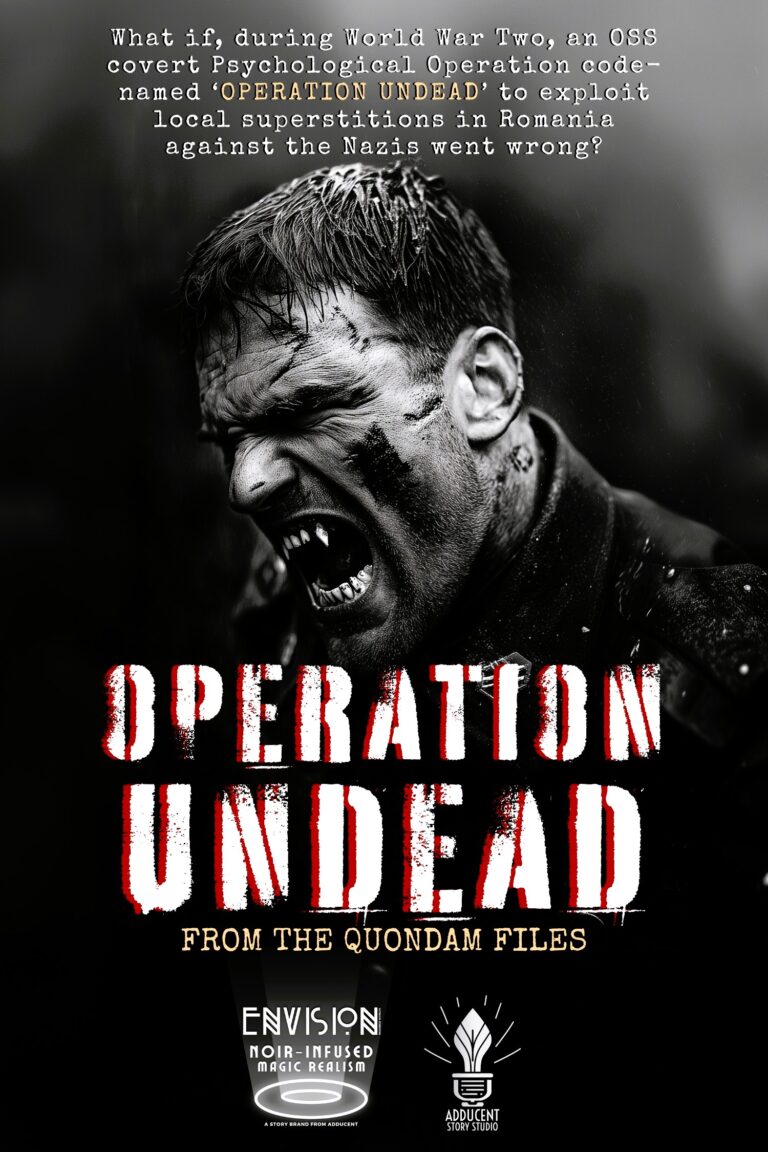
While researching one of our stories (series in development), whose main character is an ex-OSS officer (former Mercy Team, then X-2 and Secret Intelligence Branch) who operated in Romania and remains in Europe post-WW2, we came across the following (further below) and thought:
What if, during World War Two, an OSS covert Psychological Operation code-named ‘OPERATION: UNDEAD’ to exploit local superstitions in Romania against the Nazis went wrong?
We’re writing an original story that answers that question (and ties into other stories within our QUONDAM series universe). The premise, plot, character list and backstories, historical and cultural research, and story codex have been completed. Writing has commenced.
Read a spin-off story involving the protagonist of the story.
And follow OPERATION UNDEAD’s story development with the author at:
Want to become one of our Advance Readers? Contact us.
Here’s the reference we found that prompted the ‘What If?’
OSS Operations in Romania During World War II
Romania was strategically important during World War II due to its natural resources, particularly oil fields in Ploiesti, which were vital for fueling the German war machine. The OSS sought to undermine Axis influence in Romania and supported the resistance against the Nazi-backed government.
Romanian Resistance and OSS Support: In the latter part of the war, particularly after the Battle of Stalingrad, Romania’s political situation shifted. The OSS maintained contact with Romanian political and military leaders who were part of the anti-Nazi underground. Notably, the OSS worked with factions that sought to overthrow the dictatorship of Ion Antonescu, the pro-German leader of Romania. In August 1944, as the Red Army advanced into Romania, King Michael I led a coup against Antonescu and Romania switched sides to join the Allies. The OSS had helped prepare the groundwork for this realignment by fostering relationships with key anti-Axis leaders.
Operation Autonomous: One of the most notable OSS missions in Romania was Operation Autonomous in 1943. A team of British SOE (Special Operations Executive) and OSS officers parachuted into Romania to make contact with anti-Axis factions. The team, including British officers Ivor Porter, Alfred Gardyne de Chastelain, and OSS agent John Houseman (one wonders if this is the renowned British-American actor, Romanian-born as Jacques Haussmann) aimed to prepare for the possibility of Romania breaking away from the Axis. But the operation encountered numerous difficulties. The team was captured by Romanian authorities, who kept the officers in relatively good conditions despite being allied with Germany, understanding the need for future negotiations with the Allies. After the 1944 coup, the OSS and SOE agents were released.
Sabotage of Ploiesti Oil Fields: The OSS played a role in coordinating sabotage missions, targeting the oil refineries in Ploiesti, a critical supply of fuel for Nazi Germany. These operations aimed to reduce the refineries’ output, complementing the strategic bombing campaign against Ploiesti, most famously the low-level air raid known as Operation Tidal Wave in 1943.
Myths and Legends Surrounding OSS Activities in Romania
The mysterious nature of covert operations, along with Romania’s rich tradition of folklore, led to the development of myths and legends surrounding OSS involvement. Some of these tales blend historical facts with elements of fantasy and local superstition.
- Vampire Legends and Operation Undead: One of the more intriguing legends is tied to the long-standing association between Romania and vampire folklore, particularly in the region of Transylvania. According to some stories, OSS operatives, unfamiliar with local customs and tales, encountered villagers who believed their presence was linked to ancient vampire legends. In one account, an OSS team operating near the Carpathian Mountains was said to have stumbled upon a remote village that claimed to be plagued by a vampire lord. While this story is likely a fabrication, it underscores how the intersection of wartime activities and local beliefs could create eerie and fantastical narratives.
- Secret Nazi Occult Operations: Another persistent rumor was that the Nazis, who had a fascination with occultism and mysticism, were conducting secret operations in Romania to harness supernatural powers or artifacts linked to ancient Dacian or Thracian civilizations. The OSS reportedly received intelligence about these supposed missions and monitored Nazi archaeological digs and occult experiments. No solid evidence has emerged to confirm such tales, but they remain part of the shadowy lore surrounding wartime Romania.
- Ghost Army of the Carpathians: One legend suggests that an OSS-backed Romanian resistance group operating in the Carpathian Mountains developed a reputation as the ‘Ghost Army’ due to their stealth and ability to evade capture. Some say that locals believed the group had supernatural protection or that they employed psychological warfare tactics that made the Axis forces fear they were facing an otherworldly force.
While the extent of OSS operations in Romania remains shrouded in secrecy, these myths and legends highlight the nature of covert operations in a region steeped in history and folklore.
Origins of the Operation Undead Myth
Operation Undead is an interesting and rather fanciful legend, but there is no documented historical evidence to confirm the existence of any such operation carried out by the OSS or other Allied intelligence agencies during World War II. The legend likely emerged due to the deep connection between Romania, specifically Transylvania, and vampire folklore, which has captured popular imagination for centuries.
The story of Operation Undead appears to be a mix of historical fact, local superstition, and post-war embellishment. Transylvania, a region in central Romania, is famously associated with the vampire myth, mainly due to Bram Stoker’s 1897 novel Dracula and its central character, Count Dracula, who is loosely based on the historical figure Vlad the Impaler, a 15th-century ruler known for his brutal methods of punishment.
When the OSS began operations in Romania during World War II, these vampire legends were already well-known in Western popular culture. The OSS, known for using unconventional warfare and intelligence techniques, would have certainly encountered the strong superstitions and folklore permeating Romanian rural life.
The Alleged Story of Operation Undead
According to the legend, Operation Undead occurred between 1943 and 1944, during the height of the OSS’s covert activities in Eastern Europe. The story claims that an OSS team was deployed into the Carpathian Mountains on a mission to sabotage Nazi operations and gather intelligence on German troop movements. While operating in a remote village, the team encountered locals who warned them of a ‘strigoi’ (a Romanian term for a vampire-like creature) terrorizing the region.
The myth goes further to suggest that the villagers believed the strigoi was collaborating with Nazi forces, leading the OSS team to investigate the possibility that the Germans were somehow exploiting local superstitions for psychological warfare. This narrative plays into the well-documented Nazi fascination with the occult, particularly Heinrich Himmler’s SS, which was involved in pseudo-archaeological and mystical studies across Europe.
In some versions of the story, the OSS agents were caught between fighting the Axis forces and dealing with what the villagers believed was a supernatural threat. The team supposedly investigated eerie occurrences, strange disappearances, and even the discovery of a crypt in a forgotten castle, adding to the mystery of the operation. However, no actual documents, diaries, or post-war OSS reports support these fantastical claims.
Reality vs. Fiction
The OSS was involved in operations that dealt with psychological warfare and engaging local resistance movements. Its focus in Romania was practical: working with anti-Nazi elements, sabotaging key industrial infrastructure (like the Ploiesti oil fields), and gathering military intelligence.
The Operation Undead legend likely arose after the war as a mixture of:
- Real OSS and SOE operations that took place in remote and mysterious locations, naturally giving rise to imaginative speculation.
- The strong local vampire lore, especially as Western soldiers and intelligence officers encountered these cultural beliefs for the first time.
- Popular depictions of vampires in literature and movies added a gothic element to the already dramatic landscape of World War II espionage and resistance efforts in Eastern Europe.
Legacy of the Legend
While Operation Undead remains in the realm of myth, it exemplifies how war and folklore can intertwine, creating larger-than-life stories that endure long after the events themselves. The tale of OSS agents facing off against vampires or Nazi occult forces adds a supernatural element to what was otherwise a brutal and very human conflict. These legends have been further fueled by post-war books, movies, and television shows that depict wartime Romania as a land filled with gothic horror, largely inspired by Stoker’s Dracula and the region’s association with the paranormal.

